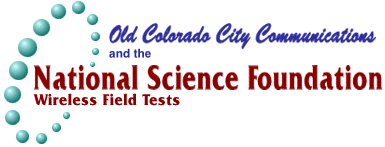
|
Voice 719.636.2040 · Fax 719.528.5869 ·Wireless Web http://wireless.oldcolo.com | ||
|
|
             |
Progress Report 7August 25th, 1997 In July, several meetings were held with LanTech, local system integrators and installers for Solectek. Three of their newest 25 mile range, 2Mbs radios were shipped to Colorado. The line of sight difficulties in linking Mitchel High School to the School District Headquarters (DIS11 is in a depression surrounded by 100 foot high trees, and Mitchell is on a plateau-shelf 3 miles east.) After several site visits, and a lot of climbing on roofs, studying (by Solectek) of geographic data bases, as well as consulting with USGS maps, rejection of numerous sites, it was decided that the only way a reliable signal can be sustained between Mitchell and the District buildings, is by shooting from the roof of Mitchell, across the city to Coronado High School, which sits on a high foothills plateou, and then back to the center of town where District Headquarters is. But to do so, towers have to be erected at two of those sites, and a tripod rooftop antenna erected at the 3d (Coronado). With the large trees, terrain, and building configurations, the estimates are that we must erect a 120' tower at the School Site, 70' at Mitchell (from the ground level) and 40' at Coronado. Not trivial. When towers that high are erected for radio use - including no-licence, FCC rules require NABER clearance and/or rules for the radio configuration, especially in view of the fact that the Penrose Hospital Helicopter Landing Pad is inside the propegation zone for the radios we are using. So we are now dealing with some of the real world problems of line of sight radio operations in a difficult center city area. San Luis Valley Several visits to the San Luis Valley were required to bring down radios from Center and Monte Vista, for reconfiguration. Attempts to get the 1 watt radios, in mid summer with the maximum foliage in a wet season, to propegate 22 miles from Center to Alamosa with a slight ground elevation between (which theoretically should not have decisively limited the connection) were unsuccessful. So the strategy of making the Monte Vista radio a 'master' with the Alamosa and Center radio's 'slaves' is now thought to be necessary, because, without any TCP/IP routing 'intelligence' in the radios, using the middle radio as a relay will not permit TCP/IP packets to be routed to the correct destination. Then we made another discovery. Several radios, rated technically the same, from the same manufacturer (Free Wave) to not appear to have the same sensitivity. One works at a site connecting from Monte Vista to Alamosa, another does not. So a series of bench tests by Mike Cheponis, in California will be necessary to see to what extent this phenonomn is a matter of consistency and quality control in the manufacture of the radios, or what might be expected 'at the margin' of range of the radios trying to connect. Laramie, Wyoming A visit was made to Laramie, Wyoming, to evaluate the wireless network put up largely at the initiative of Brett Glass, who has spent several years trying to get 'community networking' going, with the cooperation of the University of Wyoming, with its Internet connection. A seperate report on the Laramie wireless network, involving the University, the non-profit 'Lariat' organization, several companies, and the school district is on this web site.


|

